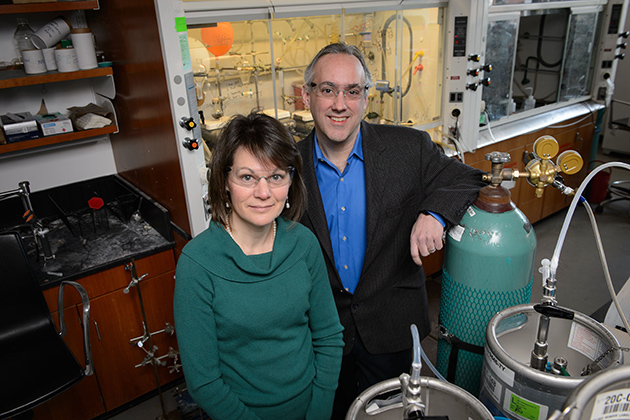
In the war against drug-resistant diseases and so-called “superbugs”, the family of bacteria known as CREs are a particularly nasty bunch.
The bacteria, whose scientific name is carbapenem-resistant Enterobacteriaceae – include notorious strains of E. coli and Klebsiella and are a constant health concern in hospitals and nursing homes, where the germs breed in ventilators, catheters, and intravenous lines.
CREs have been flagged as an “urgent threat” by the Centers for Disease Control and Prevention because of their strong resistance to antibiotics and easy transmission between humans. Some CRE bacteria are resistant to all known antibiotics. The mortality rate is high. As many as 50 percent of patients infected with CRE bacteria die because there is no drug to fight them.
But two UConn scientists may be gaining new ground against the public health threat. Professors Amy Anderson and Dennis Wright, along with their students in the School of Pharmacy, have developed a group of drug compounds that appear to be particularly effective against CREs in early tests. A lead is a preliminary molecule that shows promise and is poised for further development.
The potent compounds – part of a group of drugs known as antifolates – were a long time coming for the two, who have been searching for effective treatments for drug-resistant diseases like MRSA, E. coli, and Klebsiella pneumoniae for more than 10 years. Working with drug-resistant strains is particularly challenging for researchers, as the diseases constantly morph and evolve to fend off attacks to kill them.
We’ve made compounds that are very hard for these [bacteria] to fend off.–Dennis Wright
“It has been a holy grail to kill these types of CREs,” says Anderson, a professor of medicinal chemistry and interim head of the Department of Pharmaceutical Sciences. “These (CRE) bacteria have an extra thick, tight membrane meshed with proteins that makes it very hard for drugs to penetrate. We’ve spent years trying.”
After testing hundreds of different compounds, delicately altering each one’s chemical structure with the hope of finding the magic recipe that would serve as a CRE knockout blow, Anderson and Wright recently started seeing positive results in one particular group.
‘Our goal was to inhibit a certain enzyme in the bacteria so it can’t function and the bacteria can’t survive,” Anderson says. “When we finally got a very potent inhibition of the enzyme, that was definitely a eureka moment.”
The pair recently received a five-year, $2.7 million grant from the National Institutes of Health to further study these compounds and prepare them for clinical trials. Together, Anderson’s and Wright’s labs have received more than $10 million in federal research support since they began working on the project.Wright, a professor of medicinal chemistry, synthesizes the new drugs; Anderson evaluates them and determines the atomic details of how they interact with their intended target .
“We want to make compounds that are potent inhibitors of the growth of the bacteria and at the same time are safe, with good drug properties, so down the line they will be effective when used at a clinic,” says Wright.
At this stage in the research, Anderson and Wright are trying to learn more about the physical and chemical processes that allow their compounds to penetrate the armor-like coating around CREs when so many others have failed. Understanding why their compounds are working may allow them to apply the same biological chemistry to different compounds that could be used to fight other persistent infections. Associate professor of pharmacy practice Jeffrey Aeschlimann from UConn Health is helping with the CRE drug characterizations. University of Montana professor of chemistry Nigel Priestley is assisting with testing in early animal pre-clinical trials.
“Right now, what makes our compounds attractive is that they seem to have a very low rate of resistance,” says Wright. “We’ve made compounds that are very hard for these CREs to fend off.”
Read more about UConn’s CRE research here.



